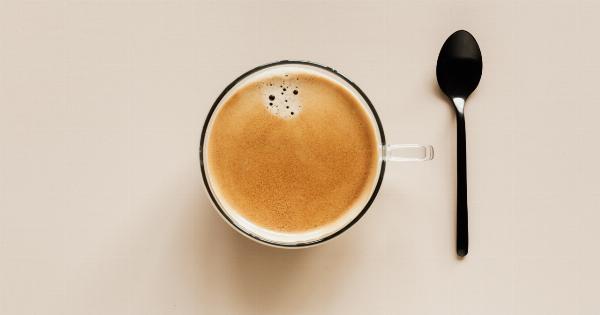Hot beverages are an integral part of our daily routine, providing us with a much-needed dose of caffeine and comfort.
Whether it’s a steaming cup of coffee or a soothing cup of tea, these beverages have become synonymous with relaxation and productivity. However, what many people fail to consider is the caloric content of these seemingly innocent drinks.
In this article, we will explore the calories in hot beverages, specifically coffee and tea, and understand the impact they can have on our overall caloric intake.
The Caloric Content of Coffee
Coffee is one of the most widely consumed beverages around the world. It is known for its ability to wake us up and keep us alert throughout the day.
However, what most coffee enthusiasts overlook is the fact that their beloved cup of joe contains calories.
The caloric content of coffee can vary significantly depending on how it is prepared and what additives are included. A plain cup of black coffee, without any cream or sugar, contains virtually zero calories.
It is a calorie-free drink that can be enjoyed guilt-free by those on a calorie-restricted diet. However, it is important to note that not everyone enjoys the bitterness of black coffee, and therefore, many people opt for various additives that can significantly increase the calorie count.
If you are someone who enjoys a splash of cream or milk in your coffee, you need to be aware of the caloric content of these additions.
A tablespoon of whole milk adds approximately 9 calories to your cup of coffee, while the same amount of cream adds around 52 calories. If you are watching your calorie intake, you might want to consider using low-fat milk or non-dairy milk alternatives, which contain fewer calories.
Another popular addition to coffee is sugar or artificial sweeteners. While these additives enhance the taste of coffee, they can also add a significant amount of calories.
A teaspoon of sugar contains approximately 16 calories, while a teaspoon of artificial sweeteners contains minimal to no calories. However, excessive intake of artificial sweeteners has been linked to various health concerns, so it is essential to use them in moderation.
In summary, a plain cup of black coffee contains negligible calories, but if you prefer to add cream, milk, sugar, or artificial sweeteners, you need to be mindful of the caloric content of these additives.
They can quickly turn your innocent cup of coffee into a significant source of calories.
The Caloric Content of Tea
Tea is another popular hot beverage that is consumed in various forms around the world. From black tea to green tea and herbal teas, there is a wide range of choices available, each with its own unique flavor and potential health benefits.
But what about the calories?.
Similar to coffee, the caloric content of tea also depends on how it is prepared and any additional ingredients that are added.
Plain tea, without any sugar or milk, is a calorie-free drink that can be enjoyed without worrying about unwanted caloric intake. It is a refreshing and hydrating beverage that can be consumed throughout the day.
However, as with coffee, many people enjoy adding milk or sweeteners to their tea. Milk has a more subtle flavor compared to coffee, but it can still alter the taste of tea and add some calories.
Just like with coffee, using low-fat milk or non-dairy milk alternatives can help reduce the caloric content. Additionally, adding sugar or artificial sweeteners to tea can also significantly increase the calorie count.
It is worth mentioning that herbal teas, which are made from various plants and herbs, might have a natural sweetness or flavor that does not require any additional additives.
These teas are often consumed for their potential health benefits, as they can be rich in antioxidants and other compounds that promote well-being.
In conclusion, plain tea is a calorie-free beverage, but if you prefer to add milk, sugar, or artificial sweeteners, you need to be cautious of the extra calories.
Choosing healthier alternatives and using moderation is key to enjoying your cup of tea without compromising your calorie intake.
The Impact of Hot Beverages on Caloric Intake
Now that we have explored the caloric content of coffee and tea, it is important to understand how these beverages can impact our overall caloric intake.
While a single cup of coffee or tea may seem insignificant in terms of calories, it is essential to consider the cumulative effect of multiple cups throughout the day.
If you are someone who enjoys multiple cups of coffee or tea daily, every additional calorie from cream, milk, sugar, or sweeteners can quickly add up.
This is particularly crucial for individuals who are following a calorie-restricted diet or those trying to maintain a healthy weight.
Furthermore, it is essential to consider the calories consumed alongside these hot beverages. Many people enjoy a morning pastry or a biscuit with their coffee or tea, which further contributes to their caloric intake.
Being mindful of these additional calories is necessary to maintain a balanced diet.
Tips for Reducing Caloric Intake from Hot Beverages
If you are concerned about the caloric impact of your favorite hot beverages, here are some tips to help you reduce your intake:.
- Choose black coffee or plain tea without any additives to enjoy a calorie-free beverage.
- If you prefer adding milk or cream, opt for low-fat milk or non-dairy alternatives to cut down on calories.
- Consider using natural sweeteners like honey or stevia instead of sugar or artificial sweeteners with potential health concerns.
- Limit the number of cups you consume daily to keep your overall caloric intake in check.
- Avoid pairing hot beverages with high-calorie snacks or pastries to prevent excessive caloric intake.
Conclusion
Hot beverages like coffee and tea have become integral parts of our lives, providing us with comfort and energy.
While they can be enjoyed guilt-free in their plain form, it is important to be aware of the potential caloric content when additives like milk, cream, sugar, or sweeteners are included. By understanding the caloric impact of these beverages and making informed choices, we can continue to savor our favorite hot drinks while maintaining a balanced diet and managing our overall caloric intake.































